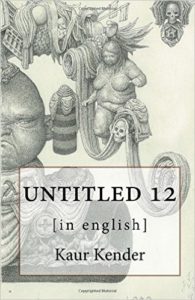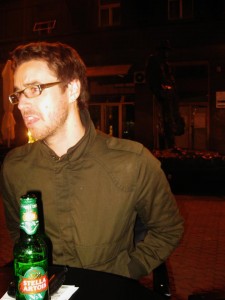Early last year the Estonian writer and controversial public figure Kaur Kender was formally charged with production of child pornography. The charges related to a novella Kender penned in the winter of 2014 entitled Untitled 12, which depicts the violent sexual abuse of women and children by an unnamed protagonist. The persecution of the novella’s author has ensured that it has achieved an infamy incommensurate with its literary worth.
Kender’s trial began in May in Tallinn. At the request of the prosecutor, Lea Pähkel, the trial has been partially closed ‘for reasons of public morality’ but Kender has made a point of publishing the court proceedings on his online portal Nihilist.fm (the same portal on which he initially published Untitled 12). The controversy was stoked further in June when the court ordered Kender to undergo a psychiatric evaluation.
The prosecution of a well-known writer has provoked outrage among much of the Estonian literary scene, with prominent intellectuals rushing, if not to support Kender, then to at least oppose the state’s persecution of him. Both the trial and psychiatric evaluation have had many critics pointing to the disturbing historical parallels of the twentieth century, with which Estonia is intimately familiar.
 Kender himself has been confused in his response to the charges. At times he has reveled in his provocative role and described himself as ‘the Estonian De Sade.’ At other times he has backed off from this controversy, insisting that there is nothing offensive about the work and that it is merely a social satire. He has even suggested that his prosecution is an act of vengeance by the ruling Reform Party for his role in publicizing the social epidemic of drug abuse in Estonia.
Kender himself has been confused in his response to the charges. At times he has reveled in his provocative role and described himself as ‘the Estonian De Sade.’ At other times he has backed off from this controversy, insisting that there is nothing offensive about the work and that it is merely a social satire. He has even suggested that his prosecution is an act of vengeance by the ruling Reform Party for his role in publicizing the social epidemic of drug abuse in Estonia.
Whatever the motivations of the public prosecutor, the trial has posed a tired set of unproductive questions that have plagued transgressive literary genres since the eighteenth century: What is the difference between art and pornography? What is the social responsibility of art? To what degree can the state regulate culture in a democracy?
In place of these questions, which are already being debated elsewhere with little result, we propose here to approach the Kender controversy from a different angle. As a work of transgressive literature, how does Untitled 12 work? Where does it sit in the canon of transgressive texts? And how are we to judge it within its own terms?
***
Untitled 12 describes the moral corruption of an unknown protagonist, whose wealth and sexual addiction lead him into darker and more violent fantasies, from pornography, to abusing child prostitutes, to domestic violence and, finally, to torture, rape and murder. In its gratuitous depictions of sex, drug abuse and violence, the novella consciously situates itself in the tradition of transgressive literature and Kender has cited the influence of De Sade’s 120 Days of Sodom, Guyotat’s Eden, Eden, Eden, and Easton Ellis’ American Psycho.
In an effort to shoe-horn an element of social commentary into his work, Kender has claimed that the piece is a ‘grotesque satirical picture’ of Estonian society, in which ‘Satan’ uses ‘undying lechery and undying debt’ to ‘run the world.’ It is the wealth of the protagonist, he argues, that allows him to exploit the women and children around him without fear of reprisal.
It is true that there are hints of social critique in the work. Significantly, Kender gives almost all of the victims Russian first names and stages some of the crimes in or around Lasnamäe, a Tallinn suburb made up of largely Russian housing projects. This ethnic dimension of the violence obliquely introduces a reference to the social stratification of post-Soviet Estonia, while giving the work an urban setting.
However, any aspirations the author may have had towards social critique are undermined by the work’s weaknesses. Indeed, even as a work of amateur horror, Untitled 12 is likely to disappoint most genre fans. Contrary to the well-meaning efforts of the Finnish PEN Club, which has publicly condemned the prosecution of Kender and described his novella as ‘a grotesque thriller,’ there is little thrill involved. There are several reasons for the weakness of the piece.
First, Kender’s decision to deploy a third person narrative voice prevents him from exploring the interiority of the protagonist in any depth. Consequently, many of the techniques that other writers of transgressive literature exploit to their advantage, are closed off to him.
In court, Kender defended his use of the third person voice by suggesting that this allows him to more directly expose the reader to the horror of the piece: ‘I’ve taken away from the reader the comfortable spot where he could go and be excited by the text. I put this text in front of the eyes of the reader, so it would have no hiding places.’
The argument here mistakenly links literary immediacy to a more direct or traumatic experience of the text. The lack of a ‘comfortable spot’ means that the reader is exposed to its horrors more fully. But even the most novice reader of horror will appreciate why this is an especially shallow understanding of how the genre works.
If we cast a brief glance at some of the most compelling texts of the transgressive canon we’ll see that they have relied heavily on the narrative possibilities opened by the first person voice. The alienating use of ‘nadsat’ in Burgess’ A Clockwork Orange, the fascinating interwoven monologues of Bruce, Carole and the tapeworm in Welsh’s Filth and Easton Ellis’ disorienting shifts from the first to third person voice at crucial moments of American Psycho; each makes use of the protagonist-narrator to dissimulate, estrange or draw the reader deeper into the horror.
Precisely what is so unnerving about the first person voice in horror fiction is that it cultivates an intimacy between the protagonist and the reader that at once offers insight into the motivations that drive the plot and, in the process, morally compromises the reader. It structurally forces an identification with the protagonist, making the reader complicit in their transgression.
In its attempt to ‘confront’ the reader, Untitled 12 offers no such space of intimacy. There is nothing with which to identify; no depth from which deeper motivations might be gleaned and no sense as to the interior world of the protagonist. Far from forcing the reader to traumatically experience the text’s horror, as Kender claims was his goal, this merely reduces its efficacy. In the absence of a narrative voice that could situate the atrocities into a meaningful-if-disturbing worldview, the text is reduced to a series of descriptive scenes.
***

The weaknesses derived from the narrative techniques compound an even deeper problem with the text, which concerns the absence of character and, therefore, plot.
Throughout the novella we have no understanding of who the protagonist is, what he does, what animates his violent sexual fantasies. Nor are we given an insight into his victims’ experience.
Kender does make some effort at providing the rudimentary elements of a character. The protagonist is clearly supposed to suffer from sexual addiction: ‘He’s a slave to his cock-stick. This meat-hose excites him, it turns hard and calls for him to masturbate.’ These opening lines give us some sense of motivation.
Elsewhere the character’s experience of his addiction is elevated into a metaphysical worldview premised on the pain of loss and emptiness of desire: ‘After orgasm, the man collapsed on him and then they cried and screamed together about their loss and the tranny fucked him in the ass with five ringed fingers to show how the man can’t feel any sexual arousal right now and how empty and painful the fuck is without it.’
But these awkward musings on the human condition always feel like filler; literary elements that Kender realizes he needs to include to string together the violent sexual scenes that are the real meat of the novella. Indeed, it is quite remarkable that Kender has been able to take such scenes of excessive, sexualized atrocity and present them with such a shallowness of prose as to make them seen utterly banal.
***
Whether read as horror or violent pornography, one is genuinely bemused that the Estonian prosecutor believes that Untitled 12 is capable of inspiring anything in its readers other than a roll of the eyes. And yet, Kender is standing trial and, if convicted, faces a minimum three year prison sentence.
The only information we have from within the proceedings are Kender’s own notes and, in the absence of any other documentation, we must base our comments on these. But if these notes are even remotely accurate in their sketch of the cross-examination, then the trial is an irresponsible waste of the Estonian state’s resources.
Putting aside the question as to whether the public prosecutor has either the experience or training to conceptually differentiate between art and pornography (a problem that has plagued philosophers, courts and artists for over a century), Pähkel’s line of questioning at times strays well beyond the purview of the investigation. Indeed, occasionally it reads as an elitist character assassination.
At one moment, for instance, Pähkel poses several leading questions concerning Kender’s secondary education and his failure to graduate from university. The implication here is very clear: good writers graduate from good institutions. As Kender didn’t graduate, he is not a good writer and his views on literature should not be taken seriously.
Kender is certainly correct to dismiss this line of questioning as both beyond the legitimate scope of the state and an expression of class snobbery. They stand in sharp contrast to his own suggestion that truck drivers and prostitutes should write more literature as ‘they have very interesting stories to tell.’ Whatever weaknesses Kender’s own work has, his insistence that literature be derived from the experiences of society’s marginalized and not from the closed walls of the university is to be commended and defended in the face of the Estonian prosecutor’s parochialism.
But the weaknesses in Kender’s novella leave him especially vulnerable to the narrow-mindedness of the Estonian public prosecutor. Indeed, at times Pähkel simply invites the author to expound his views on literature at length, and waits while he digs his own hole.
Under the scrutiny of cross-examination the contradictory public personality that Kender has crafted since the 1990s – at one moment presenting himself as a concerned activist-citizen who confronts the wealthy and privileged bourgeois with the ugly reality of ‘life in the streets,’ at another a Nietzschean superman elevated well above society and its petty laws and norms – has collapsed. The pendulum swings that Kender makes between his two public personas expose serious contradictions in his testimony that Pähkel has been able to exploit for her own ends.
One line of questioning, which cuts to the heart of the problem of Untitled 12 is worth exploring briefly as it clarified the novella’s relationship to the transgressive genre more broadly.
Pähkel: But why does it attract you so much, the sex and the shit and the drugs?
Kender: I do not know if you’ve surveilled me that much, that you think, that these things attract me. I’m attracted to literature.
Pähkel: No, I mean the topic, that you do not reflect anything –
Kender: Maybe you do not have this problem, but do you know how hard it is to think of taboos, to cross, how much energy it takes –
Pähkel: But why do you need to cross those lines?
Kender: Because for art to have some kind of meaning, it must be able to do something different in the world, it must be able to offer another look at things –
Pähkel: So you agree after all that art should have some sort of meaning –
Kender: Only for the artist, not for anybody else, the artist is responsible for himself and his work, but not responsible for other people.
This exchange is particularly revealing, not merely for exposing Kender’s inconsistency – if Untitled 12 is a ‘grotesque social satire’ written to challenge Estonia’s socio-economic inequalities, then surely Kender feels some responsibility for people besides himself – but also a deeper tension within transgressive literature.
 As the name suggests, transgressive literature is concerned with themes generally understood as outside the bounds of decency, morality or legality. Usually this implies works that explore issues of sexuality (120 Days of Sodom, Story of the Eye, Lolita), violence (A Clockwork Orange, Fight Club, American Psycho) or drug use (Trainspotting). Indeed, much of the genre’s popularity and marketability has historically been tied to its shock appeal.
As the name suggests, transgressive literature is concerned with themes generally understood as outside the bounds of decency, morality or legality. Usually this implies works that explore issues of sexuality (120 Days of Sodom, Story of the Eye, Lolita), violence (A Clockwork Orange, Fight Club, American Psycho) or drug use (Trainspotting). Indeed, much of the genre’s popularity and marketability has historically been tied to its shock appeal.
But to reduce transgressive fiction to its thematic transgression is a vulgar and shallow view. The classics of the genre are classics precisely because their attention to transgressive themes propelled them to develop new literary voices or forms, to experiment with novel techniques, to expand the scope of literature in a way that authors seeking mainstream success could not.
Trainspotting, to take one example, is not a compelling novel simply because it discusses heroin addiction, but because what Welsh did with language, character and sense of place introduced new possibilities into Scottish literature.
Welsh’s alternating use of Scots, Scottish English and Standard English, for instance, allowed him to develop a richness of character that challenged dominant assumptions about drug addiction. His characters are not the passive victims pitied by anti-drug moralists, but vivid and complicated literary subjects. While provoking laughter, disgust or horror, their language fosters an intimacy that draws the reader into their world.
Trainspotting explored the marginal and the peripheral both in its subject matter – drug addicts in Thatcher’s Britain – but also in its literary techniques, rejecting the tendencies of linguistic homogenization in the British Isles that accompanied English colonialism, British imperialism and, eventually, capitalist globalization.
Its political edge lies not in the fact that it gave the marginalized a voice (a pithy and patronizing way of thinking about the problem of social critique), rather that it spoke through the periphery. Its capacity to do this grew out of its willingness to explore transgressive themes. Transgression as a means to revealing new literary possibilities.
In the above exchange, however, Kender makes clear that the contribution of transgressive fiction lies solely in its transgression. It follows, in turn, that the key task of the writer is to put pen to paper and create a list of new taboos yet to be broken. Transgression becomes the end itself.
The obvious problem here is that for a literature to be driven by its desire to transgress social taboos, those taboos must be enforced. Here Lacan’s quip – ‘God is dead, everything is forbidden’ – is most significant. If the social norms, taboos and laws that Kender seeks to subvert are not defended, then his literature serves no purpose, has no object.
Untitled 12, in other words, structurally presupposes Pähkel and an Estonian public as figures to be provoked and outraged. It is only within such a relationship of opposition that the novella is able to accrue any literary significance. Transgressive literature is here reduced to a petty tit-for-tat with the bourgeois parochialism it seeks to provoke.
***
While Kender’s claims to have written a work of social commentary might be a disingenuous afterthought, the problems he points to in Estonian society are quite real. According to Europe 2020 indicators, Estonia is alongside Greece and Spain in suffering the highest increase in poverty and social exclusion in the years since the 2008 recession. It also has one of the highest recorded income inequalities within the EU (a situation that is exacerbated by the country’s much-vaunted flat tax).

Estonia continues to rank highest among drug-induced deaths in Europe, a problem linked to the widespread abuse of fentanyl. And this problem disproportionately effects the poorer, largely Russian neighborhoods in which Kender set Untitled 12. Indeed, Kender has claimed that it was his work publicizing this health crisis that prompted the current government to target him. Whether this is the case or not, it is certainly true that in the midst of such social dislocation, the government’s decision to dedicate its time and energy to prosecuting Kender is a disgraceful indulgence of its own authority.
Even worse, of course, are those public intellectuals that have lined up behind the state in its attack. In this regard, we agree wholeheartedly with what is perhaps Kender’s most eloquent comment from the trial: ‘If a slimeball thinks that the state needs help, then that person to me is less than zero.’
—
This piece was originally published as ‘Transgressioon kui vahend ja kui eesmärk: Kaur Kenderi protsess’ in Vikerkaar (September, 2016). Special acknowledgements to Aro Velmet for his editorial advice.

James Robertson is Assistant Professor of Politics and History at Woodbury University, Burbank, California. His work concerns the intellectual history of modern Eastern Europe. He is a member of the editorial board of LeftEast.

